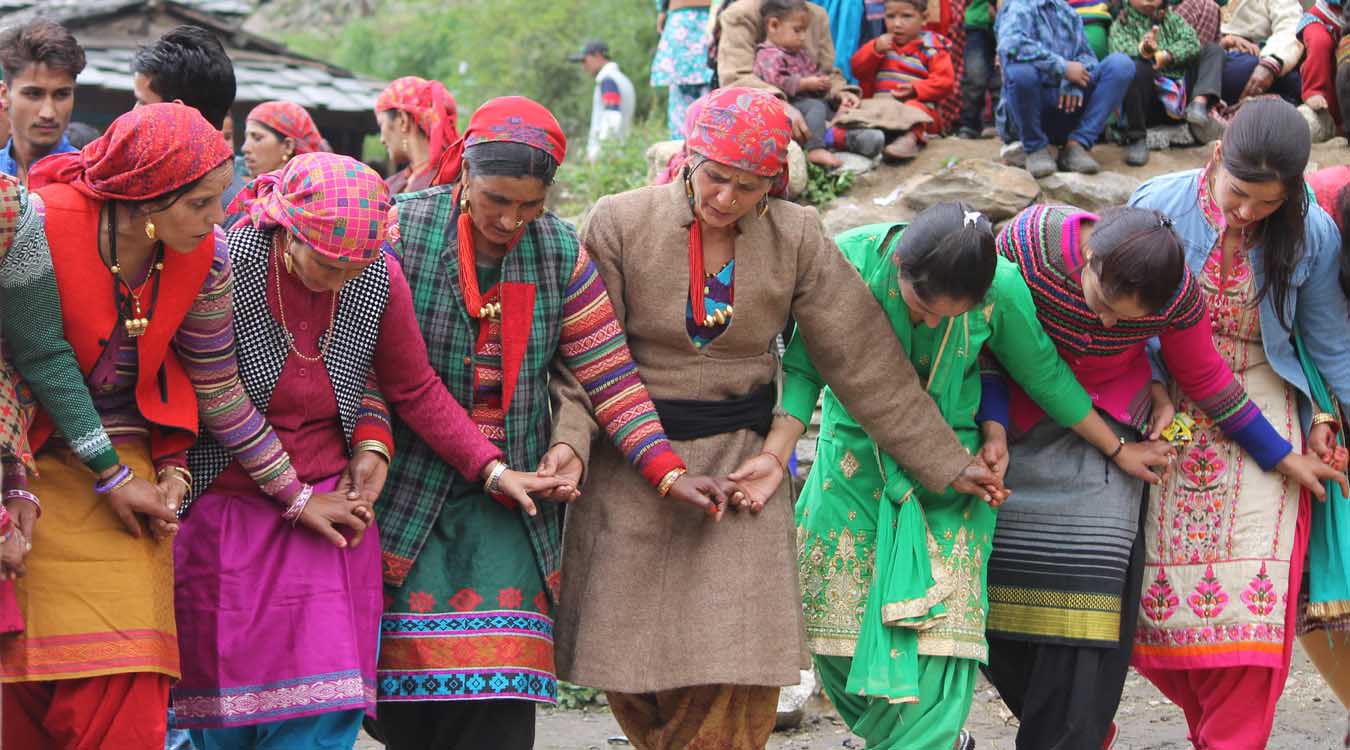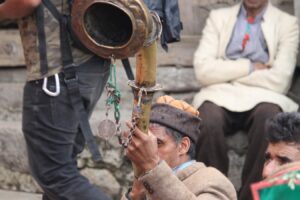Changing tunes of Uttarakhand’s folk music

Folk culture of Uttarakhand narrates tales of bravery and local stories from a bygone era (Photo Credit: indiantreks.in)
On January 14 each year as the sun traverses Tropic of Capricorn, large parts of India celebrate the harvest festival of Makar Sankranti, which coincides with the onset of an annual fair known as Magh Mela, celebrated in many parts of the northern India. On the occasion, residents of Uttarkashi in Uttarakhand take a palanquin of gods and goddesses to the Ganges for a holy dip in the wee hours of the morning. This tradition dates back to centuries when Tibetans used to visit the hilly terrain for trading their wool, herbs, cows and other animals. Today, the fair exhibits an excellent collection of local handicrafts, woollen products and rides for the visitors.
But at the centre stage of the fair is a variety of cultural activities. Folk performances, narrating tales of bravery and local stories from a bygone era, are the most popular attraction of the fair. While the essence stays, the music and dance varies from place to place. Various dances like Nati, Tandi, Raaso, Lamand, Mukhota or Pandav Nritya adorn the occasion and folk songs like Jagar, Khuded, Thadya and Jhora are popular attractions.

Folk dance and song is usually accompanied with musical instruments like Hurka, Murli and Bina, which impart the authentic taste to the local music (Photo Credit: indiantreks.in)
However, folk dance and songs are a significant part of various other everyday occasions as well. Most of the seasons have dedicated folk song like Basanti for Spring. In June, during ropaee or transplantation of crops in the Kumaon region, performances of Hurkiya Baul, a regional folk dance and song with Hurka, a percussion instrument, is commonplace. Menfolk of the villages sing songs recounting the bravery of the kings of the Chand dynasty, while women engage themselves in the field work. The entire progression looks like a dance-like sequence.
Pandav Nritya (dance of the Pandavas) is another popular folk song and dance, from the Garhwal region of Uttarakhand. The event is usually held during Dussehra and Diwali and lasts from a few days to a month. The Pandavas went to exile in the hilly terrain of Uttarakhand where they have attained a god-like significance today. Pandav stories are re-enacted by the villagers where they take roles and are often ‘possessed’ by the spirits of their characters.
While the folk culture of the state was largely restricted to its hilly boundaries, things have changed in recent times. Pritam Bartwan, commonly known as Jagar Samrat (emperor of folk music Jagar), serves as a guest lecturer at the University of Illinois in the United States. He is also a recipient of Padma Shri and Padma Bhushan, civilian honours given by the Indian government. Bartwan took Jagar to the Western world by performing at live shows.
The advent of social media has proven to be a two-sided sword for folk arts. While it has helped propagate folk music reach out to every corner of the world, it has also created challenges regarding preserving the authentic versions of the art. A few years back, Uttarakhand’s cultural anthem, Bedu pako bara masa (figs ripen round the year), was performed by Californian students at a Silicon Valley event.
However, social media has also altered folk art to a visible extent. The songs and dance forms, that were performed at private occasions or in the villages, have shifted to big stages, with pre-recorded music, a swarm of orchestra and trimmed performing minutes suited to the online audience. “Chancheri (performed in a semi-circle to a slow tempo) was performed for a long duration at fairs and villages. Today, the duration of the dance form has been trimmed to suit the YouTube audience,” Nand Kishor Hatwal, an Uttarakhand culture expert in Dehradun, tells Media India Group.
Similar to the Hindi music industry where western music elements like orchestra, hip-hop, pop, rock and electronic dance music have seeped in, the folk music of Uttarakhand has also not been able to resist it. “Things transform with time. We brought some changes in the poetry, melody and depth of rhythm when we took the baton. Today the younger generation is bringing in more changes, but these changes are not original in nature. They use the fundamentals as a tool, instead of using it as a base. So, the Garhwali essence is drifting apart from the folk music, though at a slow pace,” says Om Badhani, a Garhwali music artist.
Gauranshi Chamoli, a university student from Uttarkashi, Uttarakhand, attributes this fascination with the West to the wide variety of choices available for recreation. “Before television and Internet, people had limited options for amusement in the leisure hours. Today, Internet has opened us new doors of recreation and it is reflected in our generation’s music choice,” says Chamoli.
But many believe that the culture of the two regions is slowly fading in time. “Our culture is dying. The changes accompanied by time are the only responsible factors. But our generation is unable to welcome this change as nostalgia always sets in. When good things come to an end, it does not feel right,” adds Hatwal.
Moreover, the local languages are on the verge of dying. A gradual decline is visible across various local languages in the country. In Uttarakhand, Garhwali and Kumauni are not considered as languages, but dialects. Therefore, there is little government encouragement for the propagation of these languages, which takes a direct hit on the culture.
“Our peers call themselves pahadi (one who lives in the hills), but possess no knowledge of their heritage, which is a direct insult to our culture. But, the most important reason for this decay is the absence of any folk literature. Our history has been passed on from one generation to the other through tales and songs. Local music bands like Pandavaas (a Kumauni music group) are trying to resurrect the folk music, but efforts on a greater scale are required,” adds Chamoli.
Some folk art enthusiasts are trying to revive the local culture, especially language. At various schools across the state, Garhwali and Kumauni languages are being taught to students to rejuvenate the local culture. Efforts are also being made to drive students toward reading literature. At schools and colleges across Uttarakhand, folk dance and folk songs are always staged at every event. But a culture can only survive when the youth takes a self-driven interest in their heritage and language.









